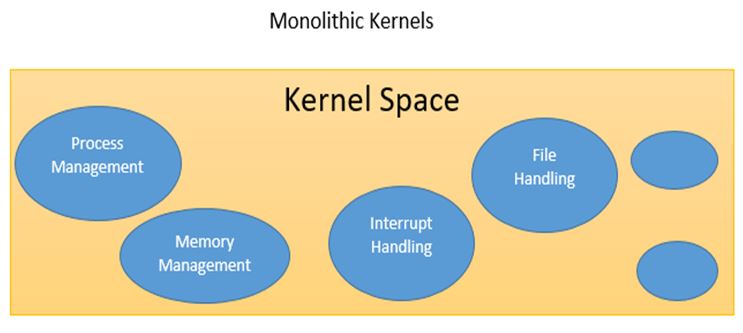操作系统大内核和微内核
As we have already studied about the Kernels, we know that the Kernel is a program which is the main component of the Operating System. Now let us study about the types of Kernels.
正如我们已经研究了内核一样 ,我们知道内核是一个程序,它是操作系统的主要组件。 现在让我们研究内核的类型。
内核类型 (Types of kernels )
A Kernel is classified into two main types:
内核分为两种主要类型:
Monolithic Kernel
整体内核
Micro Kernel
微内核
One more type of Kernel exists which is the combination of these two types of kernels and is known as the Hybrid Kernel.
存在另一种类型的内核,这是这两种类型的内核的组合,称为混合内核 。
Let us study each of them in brief...
让我们简短地研究它们中的每一个...
1)整体内核 (1) Monolithic Kernel)
In this type of Kernel architecture, all the functions, like Process Management, Memory management, interrupt handling, etc. are performed in the Kernel space.
在这种类型的内核体系结构中,所有功能(如进程管理,内存管理,中断处理等)都在内核空间中执行。
The monolithic Kernels first consisted of only one module, and this module was responsible for all the functions that were performed by the Kernel. This increased the performance of the OS as all the functions were present inside the same module, but this also led to serious drawbacks like large size of the Kernel, very low reliability because even if a single function of the Kernel failed, this led to the failure of the entire Kernel Program, and poor maintenance, due to the same reason. So, to increase the performance of the system, a modular approach was made in the Monolithic kernels in which each function was present in a different Module inside the Kernel Space. So, for fixing any bugs or in case of failure, only that particular module was unloaded and loaded after fixing.
整体式内核首先仅包含一个模块,而该模块负责内核所执行的所有功能。 由于所有功能都存在于同一模块中,因此提高了OS的性能,但这也导致了严重的缺陷,例如内核的尺寸过大,可靠性非常低,因为即使内核的单个功能失败,这也会导致由于相同的原因,整个内核程序都会失败,并且维护不善。 因此,为了提高系统性能,在Monolithic内核中采用了模块化方法,其中每个功能都存在于内核空间内的不同模块中。 因此,对于修复任何错误或出现故障的情况,修复后仅卸载和加载该特定模块。

2)微内核 (2) Micro Kernels)
In this type of Kernel architecture, the basic user services like device driver management, protocol stack management, File system management and graphics control are present in the Userspace, and the rest functions lie Memory management, Process management is present inside the Kernel space. So, whenever the system has the requirement of services present in the Kernel space, the OS switches to the Kernel Mode, and for the user level services, it switches to the User Mode. This type of Kernel Architecture reduces the size of the Kernel, but the speed of executing processes and providing other services is much slower than the Monolithic Kernels.
在这种类型的内核体系结构中,基本的用户服务(如设备驱动程序管理,协议栈管理,文件系统管理和图形控制)位于用户空间中,其余功能位于内存管理中,进程管理位于内核空间中。 因此,每当系统需要内核空间中存在的服务需求时,OS就会切换到内核模式,而对于用户级服务,它将切换到用户模式。 这种类型的内核体系结构减小了内核的大小,但是执行进程和提供其他服务的速度比Monolithic内核要慢得多。
3 *)混合内核 (3*) Hybrid Kernel)
For the best performance of the system, we require both high speed and small size of the kernel so that our system may have the maximum efficiency. So, to meet this, a new type of Kernel was designed which was somewhat a combination of the Monolithic Kernel and the MicroKernel. This type of Kernel is known as the Hybrid Kernel. Such type of Architecture is being used in almost all systems which are being manufactured nowadays.
为了使系统达到最佳性能,我们需要高速且小尺寸的内核,以使我们的系统具有最大的效率。 因此,为了解决这个问题,设计了一种新型内核,某种程度上是整体内核和微内核的组合。 这种类型的内核称为混合内核。 这种类型的体系结构已在当今正在制造的几乎所有系统中使用。
翻译自: https://www.includehelp.com/operating-systems/types-of-kernels.aspx
操作系统大内核和微内核





)



函数与示例)









